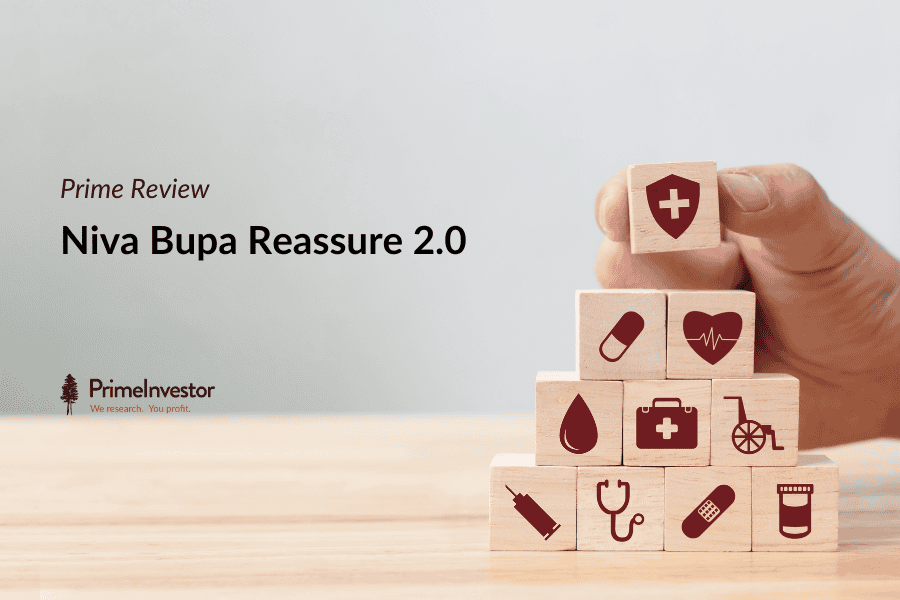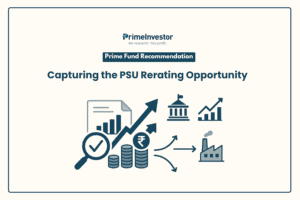There is one key difference in premium calculations between term insurance and health insurance. And that is, for term insurance, the premium is based on the entry age and remains the same throughout the policy tenure. For health insurance, the premium increases with age, regardless of the entry age.
But what if a health insurance policy could freeze the premium based on the entry age? Sounds too good to be true? In this review, we will explore a policy that claims to do just that, along with its other features: the Niva Bupa ReAssure 2.0.

Niva Bupa Health Insurance Company Limited, formerly Max Bupa, is a joint venture between Fettle Tone LLP (an affiliate of True North Fund VI LLP), an Indian private equity firm, and Bupa Singapore Holdings Pte. Limited, a UK-based healthcare services expert. As of FY23, Niva Bupa ranks 9th among health insurers in terms of premium collected. Its claim settlement ratio, based on the number of claims and the value of claims as of FY24, stands at 92% and 73.3%, respectively. The claim settlement efficiency ratio, which measures the number of claims settled within three months, is 100% as of FY24.
Policy basics
The Niva Bupa ReAssure 2.0 (Niva Bupa ReAssure) offers both individual and floater plans. It is available for individuals aged 18 to 65 years. Children with a minimum age of 91 days can be added to the policy.
The policy offers coverage ranging from Rs. 5 lakh to Rs. 1 crore. It includes multiple plans with varying benefits – Gold, Bronze, Bronze+, Platinum+, Titanium+. All plans provide the same range of sum insured options.
The policy does not have any copayment clauses and room rent limitations – a key positive.
On coverage, a health insurance policy generally covers hospitalisation expenses, where a minimum 24-hour admission is considered hospitalisation. Here is where the Niva Bupa ReAssure is slightly different from other health policies.
Niva ReAssure covers expenses even if the hospitalisation is just 2 hours. Note that there will be no payment if these short hospitalizations are for investigations and evaluations (e.g., CT Scan, Endoscopy, etc.) and not treatments.
Most other health policies cover daycare treatments; these are procedures that earlier required more than 24 hours of hospitalisation in the past but are now completed in less than a day due to advancements in technology. Most such treatments are likely to fall within the 2 to 24-hour hospitalisation duration.
Given that Niva Bupa ReAssure does not pay for short hospitalizations for investigations and evaluations, the practical coverage it offers compared to others may not be significantly different.
The policy also covers pre- and post-hospitalization expenses up to 60 and 180 days, respectively, which is on par with the industry standard.
As far as exclusions go, Niva Bupa ReAssure has standard exclusions such as investigation and evaluation, obesity/weight control, cosmetic surgeries, treatments necessitated due to participation in hazardous or adventure sports, and treatments for sterility and infertility. These are common exclusions. Additionally, the policy does not cover maternity expenses.
For a full set of exclusions, refer to the policy wordings on page 10.
Features that enhance the sum insured
The Niva Bupa ReAssure has several features that enhance the sum insured.
Booster+: This feature allows carry forward of unused base sum insured. This is similar to the no-claim bonus feature in other insurance policies. However, the increase in sum insured could be higher with the Niva Bupa ReAssure as few policies provide a 100% no-claim bonus. The number of times the sum insured can be carried forward depends on the sub-plan of the policy, varying from 3X to 10X.
ReAssureX: This feature allows the restoration of the sum insured an unlimited number of times. The maximum payout for a single claim will be up to the base sum insured. While the restoration of the sum insured is now common among insurance policies, not many policies offer unlimited restores.
ReAssure+: This feature also provides unlimited restoration like ReAssureX – but this comes with an additional feature called ‘Lock the Clock’ which locks the premium at entry age until the first claim is filed. It is this apparently attractive feature that is Niva Bupa ReAssure’s big draw. We will explore this feature in detail below.
Other Features
The policy offers the following optional benefits:
Safeguard: Every policy includes a list of items that are not covered, such as consumables like gloves and masks. The Safeguard option makes many of these items eligible for payment as part of the claim. Items listed in List I, Annexure I of the policy wordings (page 20) will be covered with this add-on. It also allows an increase in the base sum insured based on the consumer price index (CPI).
Safeguard+: This has everything in Safeguard, but has more items included in the list mentioned above. This add-on makes items listed in List I, List II, List III, and List IV of Annexure I of the policy wordings (pages 20-21) eligible for payment as part of the claim.
Decoding the signature feature: Lock the clock
The ‘Lock the Clock’ feature is available only with the Platinum+ and Titanium+ plans. The other plans provide ReAssureX instead. There are two key points to note in ‘Lock the Clock’:
- As mentioned earlier, the feature locks the premium at the entry age only until the first claim is filed. That is, your premium remains constant every year (unlike other health policies where premiums are revised on renewal based on different factors) as long as you do not make a claim.
- Once a claim is filed, the premium for the next renewal will be based on the insured’s age at that time. But very importantly, the premiums do not freeze again at this new level. After the first claim, the premium will continue to rise on renewals just as with other insurance policies, even if no further claims are raised.
Now, let’s see the impact on premiums.
The policy employs zone-based premiums, and the following premiums are for the Mumbai location. Premiums for other locations can be verified from the policy page. The premium of the sub plans of the policy for a sum insured of Rs.10 lakh for an individual plan stands as below:
For the sum insured of Rs.10 lakh, the premium for a family floater plan of 2 adults, and 2 kids stand as below:
The premiums of the Bronze plan falls at the cheaper end compared to other policies in the market, on the other end, the premiums of Titanum+ falls slightly above the market median. Now, let’s see if the lock the clock feature is truly an attractive one or not:
#1 Expensive to start with
‘Lock the clock’ is available only with the Titanium+ and Platinum+ plans as explained earlier. These are the most expensive plans among the five on offer. Essentially, to freeze the premiums, you must agree to pay a higher premium in the first place!
Here’s an example. Assume a 25 year old is contemplating between Bronze and Platinum+ plans for a sum insured of Rs.10 lakh. With Bronze, the starting premium is Rs.9,258, and it will continue to increase with age. Meanwhile Platinum+ has a premium of Rs.10,783 which will freeze the premiums until a claim is made. This premium is at the level of a 35-year old in the Bronze plan. In other words, to lock the clock, you could already be paying the premium paid by someone a decade older!
You could argue that there are other feature differences between the Platinum+ and Bronze plans. But the question is if this is worth the additional cost. So let’s see how the major features of the Bronze plan and the Platinum+ stand against each other:
What are the takeaways here? One, the plans have similar benefits on most key features. The Bronze does have an additional waiting period for pre existing diseases, but the recent IRDAI directive should change the maximum waiting period across industry to 3 years.
Two, the no claim bonus (Booster+ feature) provides more coverage under Platinum - but as we have repeatedly mentioned, we hold the view that a no claim bonus is not a replacement of coverage with certainty. The better way to increase your cover with certainty and with affordable premiums is to get a super top up plan.
For example, let’s say someone in their 20s buys basic health insurance for a sum insured of Rs.5 lakh. In their 40s, they want to increase this to Rs 15 lakh. But they see that they have a no-claim bonus of Rs.10 lakh available with the basic policy. Does this mean that they don’t have to do anything additional to get that cover of Rs 15 lakh? We don’t think so. The Rs.15 lakh cover is conditional. A few claims can deplete the no claim bonus and the coverage of the basic plan will reset to the original Rs.5 lakh.
Therefore, one needs to look beyond just immediate premium savings.
#2 Steadily higher
Under the ‘Lock the Clock’ feature, in the event of making a claim, the policy premiums will continue to rise with age, just like any other policy. Given that you started out with the more expensive plan already, the premiums that you will fall back to will steadily be on the higher side compared to other plans of the policy.
Even if one didn’t make a claim for 20 years, it is not clear from a simple savings on premium basis whether locking the clock is always beneficial. For example, In the case of a 25 year old who doesn't have to make a claim for 20 years - he/she will still be paying a premium of Rs.10,783 itself at age 45 in Titanium+. Meanwhile, the Bronze plan will see the premium increase to Rs.13,210.
But if a claim has to be made at this point, the premium of Titanium+ will change to Rs.16,164 - which is Rs.2,954 more than the Bronze plan premium. Further, any savings made in the past 20 years will be reset at an accelerated pace as premiums will be revised each year on renewal according to age hereafter.
Essentially, to benefit from locking the premium, you will need to delay making a claim as much as possible. This may result in you hesitating to make a claim, based on how much you may have to bear in additional premium outgo - for example, you may start to wonder if making a claim of Rs.40,000 is worth paying Rs.6,000 more yearly premium hereafter.
This, in our view, negates the purpose of taking on a health policy; while some health policies have co-payment clauses where you need to fork out an initial amount, these are clearly defined and are easier to work with. While deciding whether to bear the (full) cost of a low-value bill to save future premiums, there is always the uncertainty of being forced to make a high value claim in the future that invalidates the long term premium savings in the calculations.
For the family floater plan, it makes even less sense to pay the higher premium just to lock the clock as the probability of making a claim increases with more people in the policy.
Other policy drawbacks
The abundance of sub-plans, features, and add-ons makes the Niva Bupa ReAssure complex, requiring you to navigate through various combinations. Next, although the policy covers robotic surgeries, there is a maximum limit of Rs. 1,00,000 per claim for all treatments, except for total radical prostatectomy, cardiac surgeries, partial nephrectomy, and surgeries for malignancies.
The waiting period for pre-existing diseases is 4 years for Bronze and Gold plans; the recent directive on health insurance policies should however reduce it to 3 years. The waiting period for other plans is 3 years, which is longer than that of many comparable policies.
Niva Bupa ReAssure - Final Take
The ability to lock premiums at entry age is a nice feature to have, particularly if you’re looking to take a policy when young. However, this feature alone shouldn't be the sole reason to purchase a health insurance policy as premiums are high to begin with and will steadily move higher once a claim is made.
Therefore, you need to look at Niva Bupa ReAssure in terms of the other features it offers and not the premium freezing advantage. The ones we consider essential are at least single private AC room coverage, no copayments, restoration of sum insured, and reasonable maximum waiting period. On this count, the Bronze plan presents a compelling offering in our opinion. This plan has economical premiums as well. While it comes with a 4 year waiting period - longer than industry average - the recent directives should make this 3 years.
Links




8 thoughts on “Prime Review – Niva Bupa Reassure 2.0”
Really appreciate you folks writing this review for Reassure 2.0! My insurance renewal was coming up and this helped.
Thanks! glad to hear that you find it useful.
Did you renew ? I am confused between hdfc secure and niva bupa bronze
Well i guess when it comes to Health Insurance companies, no one is a saint.
I have been having an HDFC ERGO Health Insurance policy for over 14 years with a SI of 5L and have had no claims made so far. Upon seeking a migration request to Optima Secure variant, i am told that minumim SI that can be taken is 10L (even when i am seeking for 5L cover). On asking for a reason to explain why are they seeking higher SI, there is no response. I dont even know if there is any protection for an end consumer from such arbiterary decisions been imposed by the insurer. IRDAI can at best intervene only for claims that are rejected i am told. On matters such as i have experienced there are no guidelines. Sad but true.
Health insurance purchased online or directly without the help or advice of an agent in India is a grave blunder. The ground realities are harsh as the insured and their family are often at the receiving end during claims as the processes ae harrowing with no timelines and accountability.
Thanks for this review/analysis. Some of drawbacks mentioned (higher premium, limit for robotic surgery etc.) are better/addressed in the new Aspire plan. It would help if you can provide your analysis on Aspire plan as well.
A feed back regarding the NIVA BUPA reassure plan, i being a policy holder for 3 years without a claim, their Customer support is pathetic ,few practical difficulties are mentioned here, do not go for this company, they do not have any method to make a complaint, they do not reply to emails, for existing customers there is no point of contact, the phone number given by them is not a toll free number it is a chargeable number , airtel post paid subscriber can only make calls , prepaid number cannot call the 1860xxxxx number as it is chargeable,no intimation notice about the policy renewal, you have no point of contact to know details about your plan,change in plan e.t.c
Thanks – customer service is also an important element to consider as we assess the product/service.
Comments are closed.